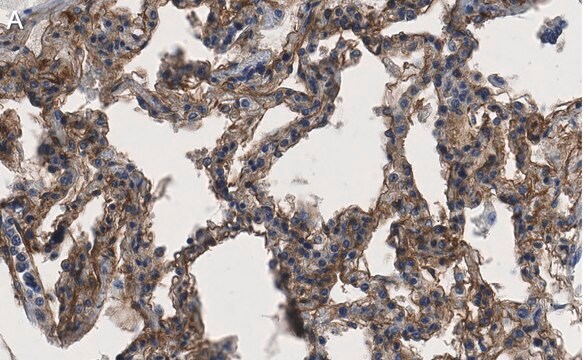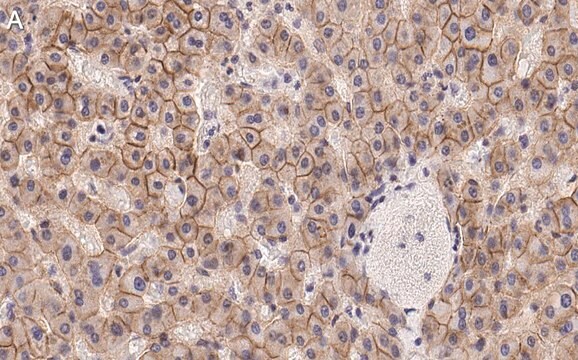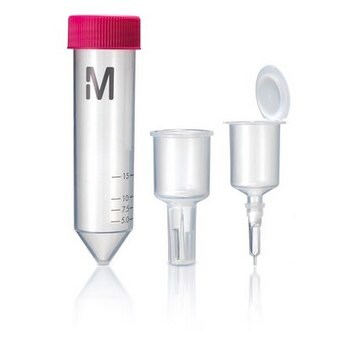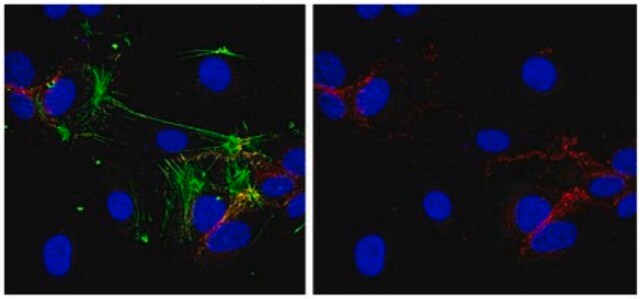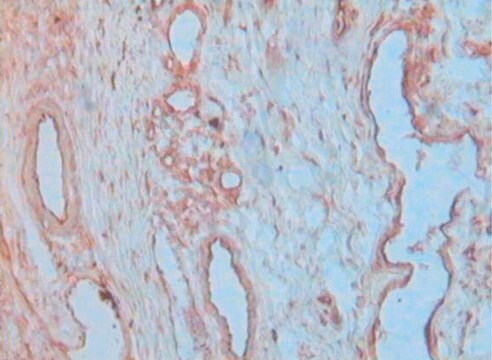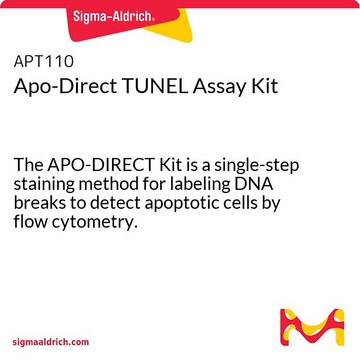一般說明
We are committed to bringing you greener alternative products, which adhere to one or more of The 12 Principles of Green Chemistry.This antibody is Preservative-free, produced without the harm or sacrifice of animals and exceptionally stable to allow for ambient shipping and storage if needed and thus aligns with "Waste Prevention", "Designing Safer Chemicals" and "Design for Energy Efficiency".
Click here for more information.
ZooMAb® antibodies represent an entirely new generation of recombinant monoclonal antibodies.Each ZooMAb® antibody is manufactured using our proprietary recombinant expression system, purified to homogeneity, and precisely dispensed to produce robust and highly reproducible lot-to-lot consistency. Only top-performing clones are released for use by researchers. Each antibody is validated for high specificity and affinity across multiple applications, including its most commonly used application. ZooMAb® antibodies are reliably available and ready to ship when you need them.
特異性
Clone 1O12 is a ZooMAb® Rabbit recombinant monoclonal antibody that specifically detects VE-Cadherin. It targets an epitope within 15 amino acids from the extracellular domain in the C-terminal half.
免疫原
KLH-conjugated linear peptide corresponding to 15 amino acids from the extracellular domain in the C-terminal half of human VE-Cadherin.
應用
Quality Control Testing
Evaluated by Western Blotting in HUVEC lysate.
Western Blotting Analysis: A 1:1,000 dilution of this antibody detected VE-Cadherin (CD144) in human umbilical vein endothelial cell (HUVEC) lysate.
Tested applications
Western Blotting Analysis: A 1:1,000 dilution from a representative lot detected VE-Cadherin in human brain tissue lysate.
Affinity Binding Assay: A representative lot of this antibody bound VE-Cadherin peptide with a KD of 9 x 10-8 in an affinity binding assay.
Immunohistochemistry (Paraffin) Analysis: A 1:100 dilution from a representative lot detected VE-Cadherin in human testis and human cerebral cortex tissue sections.
Flow Cytometry Analysis: 1 μg from a representative lot detected VE-Cadherin in one million human umbilical vein endothelial cells (HUVEC).
Immunocytochemistry Analysis: A 1:100 dilution from a representative lot detected VE-Cadherin in human umbilical vein endothelial cells (HUVEC).
Note: Actual optimal working dilutions must be determined by end user as specimens, and experimental conditions may vary with the end user
Anti-VE-Cadherin, clone 1O12 ZooMAb®, Cat. No. ZRB1286, is a recombinant Rabbit monoclonal antibody that targets VE-Cadherin and is tested for use in Affinity Binding Assay, Immunocytochemistry, Immunohistochemistry (Paraffin), and Western Blotting.
標靶描述
Cadherin-5 (UniProt: P33151; also known as 7B4 antigen, Vascular endothelial cadherin, VE-cadherin, CD144) is encoded by the CDH5 gene (Gene ID: 1003) in human. Cadherins are calcium-dependent cell adhesion proteins that preferentially interact with themselves in a homophilic manner in connecting cells and contribute to the sorting of heterogeneous cell types. They play an important role in endothelial cell biology through control of the cohesion and organization of the intercellular junctions. VE-Cadherin is a single-pass type I membrane glycoprotein that is synthesized with a signal peptide (aa 1-25) and a propeptide (aa 26-47) that are subsequently cleaved off to generate the mature form that contain an extracellular domain (aa 48-599) with five cadherin repeats, a transmembrane domain (aa 600-620), and a cytoplasmic domain ( aa 621-784). Three calcium ions are usually bound at the interface of each cadherin domain and rigidify the connections, providing a strong curvature to the full-length ectodomains. VE-cadherin is mainly expressed in endothelial tissue and in the brain and plays a pivotal role in endothelium integrity and vascular permeability. It associates with a-catenin forming a link to the cytoskeleton. It acts in concert with Krev interaction trapped protein 1 (KRIT1) and membrane palmitoylated protein 5 (MPP5) to establish and maintain correct endothelial cell polarity and vascular lumen. Amino acids region 621-660 is required for its interaction with MPP5. Two isoforms of Cadherin 5 have been described that are produced by alternative splicing. This ZooMAb® recombinant monoclonal antibody, generated by our propriety technology, offers significantly enhanced specificity, affinity, reproducibility, and stability over conventional monoclonals.
外觀
Purified recombinant rabbit monoclonal antibody IgG, lyophilized in PBS with 5% Trehalose, normal appearance a coarse or translucent resin. The PBS/trehalose components in the ZooMAb® formulation can have the appearance of a semi-solid (bead like gel) after lyophilization. This is a normal phenomenon. Please follow the recommended reconstitution procedure in the data sheet to dissolve the semi-solid, bead-like, gel-appearing material. The resulting antibody solution is completely stable and functional as proven by full functional testing. Contains no biocide or preservatives, such as azide, or any animal by-products. Larger pack sizes provided as multiples of 25 μL.
重構
300 μg/mL after reconstitution at 25 μL per vial. Please refer to guidance on suggested starting dilutions and/or titers per application and sample type.
儲存和穩定性
Recommend storage of lyophilized product at 2-8°C; Before reconstitution, micro-centrifuge vials briefly to spin down material to bottom of the vial; Reconstitute each vial by adding 25 μL of filtered lab grade water or PBS; Reconstituted antibodies can be stored at 2-8°C, or -20°C for long term storage. Avoid repeated freeze-thaws.
法律資訊
ZooMAb is a registered trademark of Merck KGaA, Darmstadt, Germany
免責聲明
Unless otherwise stated in our catalog or other company documentation accompanying the product(s), our products are intended for research use only and are not to be used for any other purpose, which includes but is not limited to, unauthorized commercial uses, in vitro diagnostic uses, ex vivo or in vivo therapeutic uses or any type of consumption or application to humans or animals.


